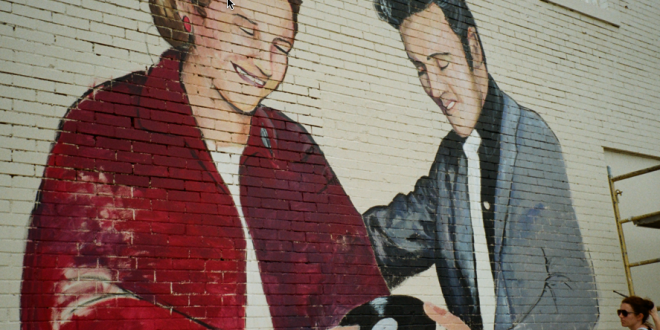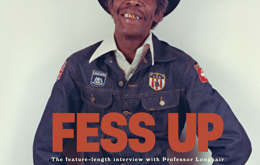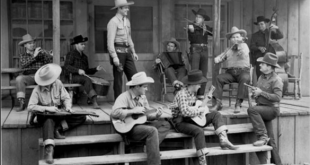While visiting my Oklahoma hometown this past May I watched artists painting a mural on the side of an old building that had once been a hotel. The evolving mural would eventually show, among other things, a depiction of songwriter Mae Boren Axton and Elvis Presley tenderly cradling a black disc as if it were a newborn. Their baby grew up to become, in a later era’s jargon for a hit record, a Monster. The disc was issued in both single formats, 78 and 45 rpms, the latter introduced by RCA in 1949 and the former going back to the turn of the century. A shiny black shellac 78 of that Monster was, alongside Burl Ives, Bob Wills and the soundtrack from South Pacific, among my family’s primordial record stash. From near-infancy I’d heard this echo-laden invitation to enter a benighted residence for the jilted who “cry there in the gloom,” a Purgatory for the unloved.
The muralists I watched working last Spring were celebrating the birth of “Heartbreak Hotel,” released by RCA January 27, 1956. Rock `n roll had been roiling under pop music’s belly for a couple of years already: Bill Haley’s “Rock Around the Clock” became the first truly rock `n roll pop chart topper in the summer of `55, and Big Joe Turner’s “Shake, Rattle and Roll” had topped the R&B charts the year prior. There were plenty of early-to-mid-`50s R&B, rockabilly and country songs suggesting the contours of rock `n roll. But it really exploded as mainstream pop music 60 years ago this month, and the catalyst was a suicide note.
“I got the Miami Herald every morning,” Tommy Durden told interviewer Barry Stutesman in a 1991 Michigan Magazine interview you can watch online. “I saw this little item one day that a man had killed himself, and all he left in way of a suicide note was `I walk a lonely street.’ That just struck me as being very….lonely. He must’ve been extremely lonely.” (Some accounts have the man jumping from a window, others shooting himself in a hotel room after first destroying anything that would identify him. A lot of this seems to be imaginative embroidery: attempts to turn up Durden’s Miami Herald story have proven fruitless, despite the appearance in a BBC Tales of Rock `n Roll documentary of the purported newspaper story, convincingly debunked in a 2014 Tulsa World article as fake.)
At the time the 35-year-old Durden was based in Gainesville, Florida, playing steel guitar with Smilin’ Jack Herring and His Swingbillies. Sideman jobs in country bands weren’t paths to fortune, so many worked other jobs or applied their musical skills to songwriting. “I started working on that idea,” said Durden, referring to the nascent song inspired by the suicide note. “I was working on a television show on Saturday at the time out of Jacksonville.” Durden wasn’t getting far with his idea, but luckily he knew a songwriter there. “I knew Mae Axton. She was a schoolteacher and songwriter and also did some public relations work for Grand Ole Opry shows, including Tom Parker and Oscar Davis, groups they would bring in. Tom Parker had just taken over as Elvis’ manager and had engineered the deal for RCA to buy his record contract from Sam Phillips, from Sun.” Axton was a relatively established songwriter, having written songs recorded by Ernest Tubb and Perry Como. She was also a college-educated lady from a political family in Oklahoma who was ambitious in a very personable way. You hear that in a May 1955 interview she did with Elvis before the writing of “Heartbreak Hotel.” The interview, perhaps the earliest surviving Elvis interview, was done for a Jacksonville radio station where the multi-tasking Mae had a show. Hearing it online, you sense that the 40-year-old Axton was genuinely interested in the rising career of this singer half her age, and that the two liked each other. Elvis complained that the Sun label lacked national distribution for his music, and the motherly Mae tells him not to be discouraged: “Of course that’s coming,” she said.
It took no time at all for Axton and Durden to co-write “Heartbreak Hotel,” according to Durden’s Michigan Magazine account. “I went up there [to Jacksonville] and I went over to Mae’s house and I told her, I said, `I have a good idea for a good blues, but I need some help. And I think that you and I can do it.’ She sat down at the piano and I walked around, walked around, and in less than half an hour we had the song.” (Many accounts credit Axton with creating the alliterative Heartbreak Hotel at the end of Durden’s evocative `lonely street.’) “We had a friend of ours named Glen Reeves make a dub [i.e. demo] on it,” said Durden. “He could sing a lot like Elvis, so he kind of did a halfway Elvis imitation on the dub on tape.”
Nashville lore is littered with tales of songs lingering unheard for years before ever being recorded. This wasn’t like that at all. Axton and Durden wrote the song in September, four months after Axton first met Elvis and learned he was looking for fresh material. “Heartbreak Hotel” was tailored to be pitched to one artist. On November 10 a country DJ convention commenced in Nashville, and Mae Axton was there with one goal: reconnect with Elvis. Writing in Last Train to Memphis: The Rise of Elvis Presley, Peter Guralnick described the pitch: “Mae Boren Axton, the lady from Jacksonville who worked for Colonel in Florida, had been trying to get him to listen to this song ever since he got in—she kept saying it would be his first million-seller, he could have it if he would just make it his first single release for RCA, she was so pleased that he had gotten this wonderful deal.” (In late October RCA bought Elvis’ contract from Sun.) When Elvis finally agreed to hear the song, Guralnick writes, “he really liked it, he said, `Hot dog, Mae, play it again,’ and she played it over and over—it was really different…He knew the whole song before he left the room. `That’s gonna be my next record,’ he said…”
The New Year of 1956 brought Elvis back to Nashville for his first RCA recording session. It commenced the afternoon of Jan. 10 with a cover of Ray Charles’ “I Got a Woman,” which Elvis had been performing onstage for awhile. That got everyone warmed up for the song Elvis had heard for the first time scarcely two months prior but which he liked enough to peg for his first major label single. It was a big gamble, and not everyone bet with the artist. Guralnick reports tension at this session, given the tall expectations for RCA’s unconventional new signing and misgivings widely felt over what he calls “an odd, almost morbid composition.” Considering that America’s top song at the moment was Dean Martin’s “Memories Are Made of This,” it must have felt like a giant step into the abyss.
“Heartbreak Hotel” was unlike anything Elvis had cut at Sun, and nothing remotely like it came later, either. It fits no neat genre category. Spurned love is its emotional core but it’s no conventional pop song about being in love or falling into/ out of love. It has something in common with the country story song tradition, but it offers no central character aside from the place and the pall it casts over its inmates. There’s no narrative of events as in folk or country story songs. It’s almost its own genre, a tragic novelty song. Novelty songs offer exaggerated descriptions for comic effect. Here we get a weeping bellhop and desk clerk dressed in mourning, exemplars of the hotel’s air of utter misery. It has a brooding darkness akin to that of such tango tinged Depression-era songs as “Boulevard of Broken Dreams.” (“I walk along the street of sorrow, the boulevard of broken dreams…”) If “Heartbreak Hotel” had appeared a couple of decades prior it might’ve been turned into a bizarre cartoon by the Max Fleischer crew, whose animators appear to have ingested hallucinogenic bathtub gin before subjecting poor Betty Boop to hair-raising trials in the company of Mysterious Mose and the Old Man from the Mountain.
Elvis knew something the RCA brass and Sun’s Sam Phillips, who called the song `a morbid mess,’ did not: he knew how to make it work. A lot of that comes across in the recording he made on Jan. 10, but his performances add another dimension. Ages before the Who’s Tommy or the camp Grand Guignol of Alice Cooper or even the Beatles’ Sgt. Pepper’s…, “Heartbreak Hotel” was rock theater. Like much avant-garde theater the intent was ambiguous: The lyrics tell one story while Elvis’ performances, bump-and-grinding teases minus the strip, tell another. Were the lyrics incidental to the show? No, they were integral to it. “Heartbreak Hotel” was at one with the sex-death nexus that animated a lot of `50s pop culture and some high culture too. It’s all over the James Dean films, Rebel… most obviously, and Tennessee Williams’ plays and let’s not forget the Beats. For a moment at least Elvis channeled that potent dark energy. It had never been done in quite that way, and the world would be awed and mesmerized and somewhat appalled. Was this a threat or a joke? Elvis, ever polite in interviews, wasn’t telling. He insisted he was just an entertainer, but the frenzy that trailed in his wake suggested he’d tapped into something deep and scary, beyond control.
Controlling Elvis, it turned out, wasn’t really all that hard. He would compliantly be led to record tripe like “Teddy Bear” in 1957, its lyrics proclaiming loudly that Elvis was now safely gelded. It was inevitable, given the furor that built around him in `56 and the fact that corporate entities like RCA only like wild cards they can play. But the TV appearances and national stardom and pressure to tame him were still to come in January 1956, which is arguably when Elvis peaked as creative recording artist. Aside from “Heartbreak Hotel” he recorded his best Sun record, even though he was now at RCA. “My Baby Left Me” was the third and final song Elvis covered from the catalogue of Mississippi bluesman Arthur `Big Boy’ Crudup. Drummer D.J. Fontana, the newcomer to Elvis’ group, starts the record with a bang and provides a supple spine throughout the performance. Elvis’ phrasing of the lyric delivers passionate dismay (“My baby left me, never said a word…”) while guitarist Scotty Moore solos at his clean and lean best. All the vocal elements Elvis garnered from blues, gospel and country gel as well as they possibly could on that record, a tight little two-minute masterpiece.
But as promised his first RCA single was “Heartbreak Hotel,” released Jan. 27, 1956. The next day Elvis made his first national TV appearance on CBS’s Stage Show, which featured big band veterans Tommy and Jimmy Dorsey. Well-intentioned though it surely was, the pairing of “Heartbreak Hotel” with the Dorsey band was mildly disastrous and the audience seemed as much bemused as excited by the newcomer likened in his introduction to Johnnie Ray. But Elvis had enough momentum going to keep getting invited back onto Stage Show, and by the time he next sang the song there (on his fifth appearance, March 17), the shrieks of adulation confirm that what he intuited about the song, by then a hit, had been right. Songwriters Durden and Axton were seemingly too old to channel teen angst, in which heartbreak plays such a strong role, but Elvis, who turned 21 just two days before recording “Heartbreak Hotel,” was another story. The song fully delivered on Mae Axton’s promises and inspired at least two other songs too good in their own right to be dismissed as knockoffs, the gospel-drenched torment of Ray Charles’ “Lonely Avenue” (written by Doc Pomus) and Carl Belew’s wistful country weeper “Lonely Street.”
Happy ending? Not entirely. Songwriter Tommy Durden said “Heartbreak Hotel” “paid my rent for 20 years” but outlived the song’s best breadwinning years: he became a dishwasher repairman. Mae Boren Axton’s knack for spotting and encouraging young talent made her a much-loved lady in Nashville, though her Elvis experience was unique in terms of success. She suffered a heart attack at age 82 and drowned in her hot tub. Elvis, surrounded by enablers of his delusions and addiction, famously succumbed to his excesses and isolation at an age nearly half Axton’s. There were no easy exits from Heartbreak Hotel.
And what of that mural I saw being painted? Why is it where it is? Here’s the explanation offered by the May 28, 2015 Duncan (OK) Banner:
“Elvis Presley, Hoyt Axton and Mae Boren Axton will soon adorn the east side of the old Henderson Furniture Building thanks to Palmer Studios and the Oklahoma Arts Council’s Rhythm and Routes campaign.
Rhythm and Routes is providing an historical and musical mural on the east side of the Henderson Furniture building on Main Street, the former site of a hotel which is said to be part of the inspiration for the famous Elvis Presley ballad `Heartbreak Hotel.’
Rhythm and Roots is a state wide initiative featuring musicians, singers and songwriters from Oklahoma. The state has selected 50 people to start with and two of those are from Duncan.
Hoyt Wayne Axton and Mae Boren Axton are both being inducted.
Hoyt Axton was born on March 25, 1938, in Duncan, to John T. Axton, a Navy officer, and Mae Boren Axton, an English teacher and songwriter. He died in 1999.”
The day after that appeared I went to check out the mural and chat with the muralists. They knew nothing about the story. The overseer of the project was likewise clueless as to the building’s claimed connection to the song, though he thought Mae Axton may have once lived there. He suggested I talk to the owner of the now-resident electrical supply and lighting business: “He knows the whole history.” I went in and asked for the boss but was told he was out on a job, so I remain in the dark as to what role, if any, is claimed for the former Traveler’s Hotel in inspiring a song which, 60 years ago this month, heralded rock’s ascent. The building is just west of the railroad tracks on a rise which, from one perspective, could be deemed the end of Main Street. If Axton lived in that hotel for awhile, might she have remembered it years later as a hotel “down at the end of lonely street?” Who knows?
Strangely there’s another former hotel building right across from the old Traveler’s in town with an Elvis/songwriter connection. For decades it was the Wade Hotel. Oklahoma-born bluesman Lowell Fulson worked there briefly after serving in World War II. He then moved to California and became a vital part of the blues scene in both the Bay Area and Los Angeles. Ray Charles once played piano for Fulson, who scored a big R&B hit in 1954 with “Reconsider Baby.” Elvis, who never lost his love for blues, covered it in 1960. It was no Monster, like the song somehow supposedly connected to the hotel across the street, but in 1993 “Reconsider Baby” got inducted into the Blues Foundation Hall of Fame anyway.
 Baja Review A community newspaper serving Ensenada, Valle de Guadalupe, and Rosarito in Northern Baja California
Baja Review A community newspaper serving Ensenada, Valle de Guadalupe, and Rosarito in Northern Baja California





